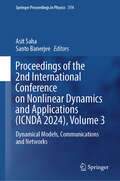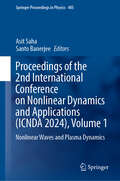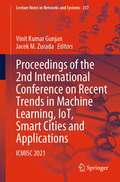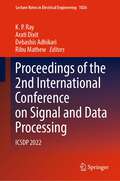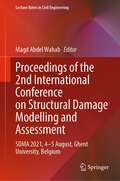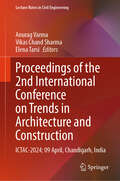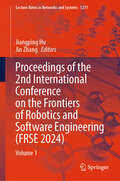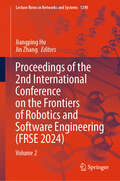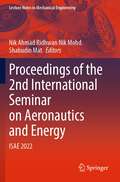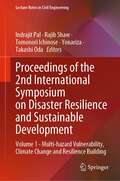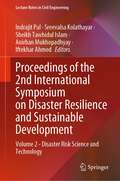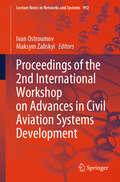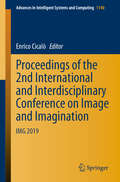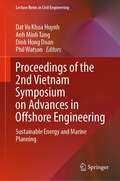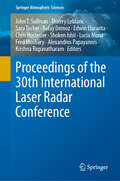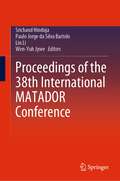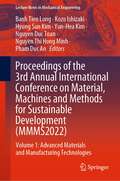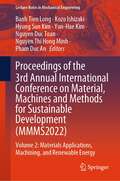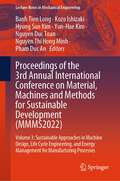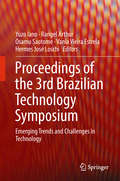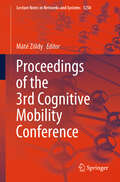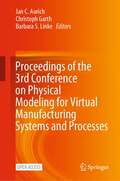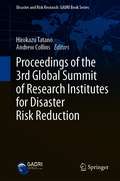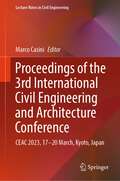- Table View
- List View
Proceedings of the 2nd International Conference on Nonlinear Dynamics and Applications: Dynamical Models, Communications and Networks (Springer Proceedings in Physics #314)
by Santo Banerjee Asit SahaThis book covers the latest advancements and applications of nonlinear dynamics in various fields of science and engineering, presenting a curated selection of peer-reviewed contributions at the 2nd International Conference on Nonlinear Dynamics and Applications (ICNDA 2024) at Sikkim Manipal Institute of Technology (SMIT). Organized by the Department of Mathematics, SMIT, SMU, this international conference provides a platform for scientists, researchers, and inventors to share their findings and exchange ideas in the ever-evolving field of nonlinear dynamics. This book comprises three volumes. Volume 3 focuses on graphs, networks, and communications. It covers topics such as optimization in control and neural systems; machine learning for signal analysis and classification; graph theory applications in science and engineering; analysis of wavelets and transforms in signal processing; and semiconductor devices and nanomaterials.
Proceedings of the 2nd International Conference on Nonlinear Dynamics and Applications: Nonlinear Waves and Plasma Dynamics (Springer Proceedings in Physics #405)
by Santo Banerjee Asit SahaThis book covers the latest advancements and applications of nonlinear dynamics in various fields of science and engineering, presenting a curated selection of peer-reviewed contributions at the 2nd International Conference on Nonlinear Dynamics and Applications (ICNDA 2024) at Sikkim Manipal Institute of Technology (SMIT). Organized by the Department of Mathematics, SMIT, SMU, this international conference provides a platform for scientists, researchers, and inventors to share their findings and exchange ideas in the ever-evolving field of nonlinear dynamics. This book comprises three volumes. Volume 1 focuses on the investigation of nonlinear waves and plasma dynamics. It covers topics such as strong Landau damping, electron plasma waves, ion-acoustic waves, dusty plasma, dust-acoustic waves, dust-ion-acoustic waves, kinetic Alfven waves, solitary wave, shock waves, periodic wave, cnoidal wave, superperiodic wave, soliton, resonance, lump soliton, multi-soliton, breather wave, upper hybrid wave, atmospheric internal wave, mathematical and analytical methods, quantum and relativistic plasmas, wave instabilities and interactions, fractional and complex systems, nonlinear optical phenomena, Gaussian laser beam, chaos and multistability, and other specific plasma studies.
Proceedings of the 2nd International Conference on Recent Trends in Machine Learning, IoT, Smart Cities and Applications: ICMISC 2021 (Lecture Notes in Networks and Systems #237)
by Vinit Kumar Gunjan Jacek M. ZuradaThis book contains original, peer-reviewed research articles from the Second International Conference on Recent Trends in Machine Learning, IoT, Smart Cities and Applications, held in March 28-29th 2021 at CMR Institute of Technology, Hyderabad, Telangana India. It covers the latest research trends and developments in areas of machine learning, artificial intelligence, neural networks, cyber-physical systems, cybernetics, with emphasis on applications in smart cities, Internet of Things, practical data science and cognition. The book focuses on the comprehensive tenets of artificial intelligence, machine learning and deep learning to emphasize its use in modelling, identification, optimization, prediction, forecasting and control of future intelligent systems. Submissions were solicited of unpublished material, and present in-depth fundamental research contributions from a methodological/application perspective in understanding artificial intelligence and machine learning approaches and their capabilities in solving a diverse range of problems in industries and its real-world applications.
Proceedings of the 2nd International Conference on Signal and Data Processing: ICSDP 2022 (Lecture Notes in Electrical Engineering #1026)
by K. P. Ray Debashis Adhikari Arati Dixit Ribu MathewThis volume comprises the select proceedings of the 2nd International Conference on Signal & Data Processing (ICSDP) 2022. The contents focus on the latest research and developments in the field of artificial intelligence & machine learning, Internet of things (IoT), cybernetics, advanced communication systems, VLSI embedded systems, power electronics and automation, MEMS/ nanotechnology, renewable energy, bioinformatics, data acquisition and mining, antenna & RF systems, power systems, biomedical engineering, aerospace & navigation. This volume will prove to be a valuable resource for those in academia and industry.
Proceedings of the 2nd International Conference on Structural Damage Modelling and Assessment: SDMA 2021, 4–5 August, Ghent University, Belgium (Lecture Notes in Civil Engineering #204)
by Magd Abdel WahabThis book comprises the select proceedings from the 2nd International Conference on Structural Damage Modelling and Assessment (SDMA 2021) held in the city of Ghent, Belgium, on 4–5 August 2021. It discusses the recent advances in fields related to damage modelling, damage detection and assessment, non-destructive testing and evaluation, structure integrity and structural health monitoring. The conference covers all research topics and applications relevant to structural damage modelling and assessment using theoretical, numerical and experimental techniques. This book is useful to scientists and engineers in academia and industry who are interested in the field of structural damage and integrity.
Proceedings of the 2nd International Conference on Trends in Architecture and Construction: ICTAC-2024; 09 April, Chandigarh, India (Lecture Notes in Civil Engineering #527)
by Anurag Varma Vikas Chand Sharma Elena TarsiThis book includes peer reviewed article from the 2nd International Conference on Trends in Architecture and Construction (ICTAC-2024) held at Chandigarh in India. It explores modernity, sustainability, technology, and education within the ever-evolving architectural landscape. This book echoes a collective dedication to fostering environmentally conscious urban practices. It navigates the symbiotic relationship between technology and architecture, shining a spotlight on the pivotal roles of AI, digital tools, and cutting-edge construction techniques. Beyond the tangible, the publication illuminates the shifting terrain of architectural education, honing in on emerging research paradigms and the integration of innovative pedagogies. Rooted in sustainability, this compendium stands as a vibrant repository of insightful contributions, nurturing an expansive dialogue on the future trajectory of architecture.
Proceedings of the 2nd International Conference on Water Energy Food and Sustainability (ICoWEFS 2022)
by Pedro Monteiro João Rafael da Costa Sanches Galvão Paulo Sérgio Duque de Brito Filipe dos Santos Neves Henrique de Amorim Almeida Joel Oliveira Correia Vasco Ricardo de Jesus Gomes Sandra de Jesus Martins Mourato Vânia Sofia Santos Ribeiro Roberta Panizio Luís Calado Ana Carolina Assis Flávio CraveiroThis book publishes some papers presented at The International Conference on Water Energy Food and Sustainability (ICoWEFS 2023), a major forum to foster innovation and exchange knowledge in the water-energy-food nexus. The topics covered embrace the Sustainable Development Goals (SDGs) of the United Nations, including Future trends in Water Security, Smart Technologies in Sustainable Energy Production Systems, Circular systems for rural and urban food and Integrated Ecosystems Management.
Proceedings of the 2nd International Conference on the Frontiers of Robotics and Software Engineering: Volume 1 (Lecture Notes in Networks and Systems #1271)
by Jin Zhang Jiangping HuThe proceeding of FRSE presents a collection of innovation research in the cutting edge fields of robotics and software engineering. It is highlighted within that there are novel methodologies, critical analyses, and breakthrough results which emphasize the enhanced or amplified results achieved when robotics technologies are integrated with advanced software. This book is outfitted with numerous diagrams, tables, and conceptual frameworks, structured to enhance comprehension and accessibility, that facilitate a deeper understanding of complex topics. The presentation is not just theoretical but includes case studies and real-world applications, offering a practical approach to complex problem-solving techniques across related industries. Readers will receive benefits from this comprehensive resource, gain a renew understanding of contemporary challenges and innovative solutions in robotics and software engineering. And this book will be a guide and asset for research scholars and professionals in robotics and software engineering looking to apply these these cutting-edge technologies in impactful ways.
Proceedings of the 2nd International Conference on the Frontiers of Robotics and Software Engineering: Volume 2 (Lecture Notes in Networks and Systems #1290)
by Jin Zhang Jiangping HuThe proceeding of FRSE presents a collection of innovation research in the cutting edge fields of robotics and software engineering. It is highlighted within that there are novel methodologies, critical analyses, and breakthrough results which emphasize the enhanced or amplified results achieved when robotics technologies are integrated with advanced software. This book is outfitted with numerous diagrams, tables, and conceptual frameworks, structured to enhance comprehension and accessibility, that facilitate a deeper understanding of complex topics. The presentation is not just theoretical but includes case studies and real-world applications, offering a practical approach to complex problem-solving techniques across related industries. Readers will receive benefits from this comprehensive resource, gain a renew understanding of contemporary challenges and innovative solutions in robotics and software engineering. And this book will be a guide and asset for research scholars and professionals in robotics and software engineering looking to apply these these cutting-edge technologies in impactful ways.
Proceedings of the 2nd International Seminar on Aeronautics and Energy: ISAE 2022 (Lecture Notes in Mechanical Engineering)
by Nik Ahmad Ridhwan Nik Mohd. Shabudin MatThis book consists of selected peer-reviewed papers from the 2nd International Seminar on Aeronautics and Energy (ISAE 2022) focusing on the theme to revive the aviation industry post-COVID-19 pandemic. The topics discussed in this book include aircraft design and optimization, computational fluid dynamics (CFD) simulation and experimental aerodynamics, aircraft structure and aeroelasticity, guidance control and navigation, aircraft manufacturing and health monitoring avionics and system integration of UAV/drones, SITL AND HITL application on drones, rockets and missile, industrial wind engineering, green fuel and aviation sustainability, and aviation management. This book is a valuable resource for academicians and industry players in the field of aviation and sustainability.
Proceedings of the 2nd International Symposium on Disaster Resilience and Sustainable Development: Volume 1 - Multi-hazard Vulnerability, Climate Change and Resilience Building (Lecture Notes in Civil Engineering #283)
by Rajib Shaw Indrajit Pal Tomonori Ichinose Yonariza Takashi OdaThis, conference proceeding, book contains invited articles and contributory papers from the 2nd International Symposium on Disaster Resilience and Sustainable Development, organized by Asian Institute of Technology, Thailand, on June 24–25, 2021. It includes contributions from researchers and practitioners working in the area of disaster mitigation and risk reduction for sustainable communities. The articles cover the topics such as on tools and techniques of hazard identifications, risk assessment, engineering innovations for hazard mitigation, and safe design of structures to the vulnerable systems. The content caters to research scholars, students, industry professionals, data analytics companies, re-insurance companies, government bodies and policymakers, who work in the field of hazard modeling and disaster management.
Proceedings of the 2nd International Symposium on Disaster Resilience and Sustainable Development: Volume 2 - Disaster Risk Science and Technology (Lecture Notes in Civil Engineering #294)
by Anirban Mukhopadhyay Indrajit Pal Sreevalsa Kolathayar Iftekhar Ahmed Sheikh Tawhidul IslamThis, conference proceeding, book contains invited articles and contributory papers from the 2nd International Symposium on Disaster Resilience and Sustainable Development, organized by Asian Institute of Technology, Thailand, on June 24–25, 2021. It includes contributions from researchers and practitioners working in the area of disaster mitigation and risk reduction for sustainable communities. The articles cover the topics such as on tools and techniques of hazard identifications, risk assessment, engineering innovations for hazard mitigation, and safe design of structures to the vulnerable systems. The content caters to research scholars, students, industry professionals, data analytics companies, re-insurance companies, government bodies and policymakers, who work in the field of hazard modeling and disaster management.
Proceedings of the 2nd International Workshop on Advances in Civil Aviation Systems Development (Lecture Notes in Networks and Systems #992)
by Ivan Ostroumov Maksym ZaliskyiThis book includes high-quality research papers presented at 2nd International Workshop on Advances in Civil Aviation Systems Development (ACASD 2024), which was at National Aviation University, Kyiv Ukraine, on March 26, 2024. This book presents original results of a scholarly study of unique research teams and market leaders on the development in civil aviation systems and its application. The book topics include major research areas focused on advances in air traffic management, data processing in civil aviation, automatic control in civil aviation systems, modern trends in navigation systems development, methods of operational efficiency improvement, human factor, and application of artificial intelligence in civil aviation systems. This book is useful for scholars and professionals in the civil aviation domain.
Proceedings of the 2nd International and Interdisciplinary Conference on Image and Imagination: IMG 2019 (Advances in Intelligent Systems and Computing #1140)
by Enrico CicalòThis book gathers peer-reviewed papers presented at the 1st International and Interdisciplinary Conference on Image and Imagination (IMG 2019), held in Alghero, Italy, in July 2019. Highlighting interdisciplinary and multi-disciplinary research concerning graphics science and education, the papers address theoretical research as well as applications, including education, in several fields of science, technology and art. Mainly focusing on graphics for communication, visualization, description and storytelling, and for learning and thought construction, the book provides architects, engineers, computer scientists, and designers with the latest advances in the field, particularly in the context of science, arts and education.
Proceedings of the 2nd Vietnam Symposium on Advances in Offshore Engineering: Sustainable Energy and Marine Planning (Lecture Notes in Civil Engineering #208)
by Dinh Hong Doan Anh Minh Tang Dat Vu Khoa Huynh Phil WatsonThis book gathers a selection of refereed papers presented at the 2nd Vietnam Symposium on Advances in Offshore Engineering (VSOE 2021), held in 2022 in Ho Chi Minh City, Vietnam. The book consists of articles written by researchers, practitioners, policymakers, and entrepreneurs addressing the important topic of technological and policy changes intended to promote renewable energies and to generate business opportunities in oil and gas and offshore renewable energy. With a special focus on sustainable energy and marine planning, the book brings together the latest lessons learned in offshore engineering, technological innovations, cost-effective and safer foundations and structural solutions, environmental protection, hazards, vulnerability, and risk management. Its content caters to graduate students, researchers, and industrial practitioners working in the fields of offshore engineering and renewable energies.
Proceedings of the 30th International Laser Radar Conference (Springer Atmospheric Sciences)
by Sara Tucker John T. Sullivan Thierry Leblanc Belay Demoz Edwin Eloranta Chris Hostetler Shoken Ishii Lucia Mona Fred Moshary Alexandros Papayannis Krishna RupavatharamThis volume presents papers from the biennial International Laser Radar Conference (ILRC), the world’s leading event in the field of atmospheric research using lidar. With growing environmental concerns to address such as air quality deterioration, stratospheric ozone depletion, extreme weather events, and changing climate, the lidar technique has never been as critical as it is today to monitor, alert, and help solve current and emerging problems of this century. The 30th occurrence of the ILRC unveils many of the newest results and discoveries in atmospheric science and laser remote sensing technology. The 30th ILRC conference program included all contemporary ILRC themes, leveraging on both the past events’ legacy and the latest advances in lidar technologies and scientific discoveries, with participation by young scientists particularly encouraged. This proceedings volume includes a compilation of cutting-edge research on the following themes: new lidar techniques and methodologies; measurement of clouds and aerosol properties; atmospheric temperature, wind, turbulence, and waves; atmospheric boundary layer processes and their role in air quality and climate; greenhouse gases, tracers, and transport in the free troposphere and above; the upper mesosphere and lower thermosphere; synergistic use of multiple instruments and techniques, networks and campaigns; model validation and data assimilation using lidar measurements; space-borne lidar missions, instruments and science; ocean lidar instrumentation, techniques, and retrievals; and past, present and future synergy of heterodyne and direct detection lidar applications. In addition, special sessions celebrated 50 years of lidar atmospheric observations since the first ILRC, comprising review talks followed by a plenary discussion on anticipated future directions.
Proceedings of the 38th International MATADOR Conference
by Lin Li Paulo Jorge da Silva Bartolo Srichand Hinduja Wen-Yuh JyweThis book presents 58 refereed papers given at the 38th Matador Conference held at National Formosa University, Taiwan in March 2015. The MATADOR series of conferences covers the topics of manufacturing automation and systems technology, applications, design, organisation and management, and research. These proceedings include original papers contributed by researchers from around the globe, covering the principles, techniques and applications in the aerospace, automotive, biomedical, energy, consumable goods and process industries.The topics include: • Additive Manufacturing • Design and System Engineering • Innovative Manufacturing and Design • Laser Processing • Machining • Metrology and Measurement • Micro/Nano Fabrication and Manipulation • Monitoring and Control of Machining Operations • Welding
Proceedings of the 3rd Annual International Conference on Material, Machines and Methods for Sustainable Development: Volume 1: Advanced Materials and Manufacturing Technologies (Lecture Notes in Mechanical Engineering)
by Banh Tien Long Kozo Ishizaki Nguyen Duc Toan Hyung Sun Kim Yun-Hea Kim Nguyen Thi Hong Minh Pham Duc AnThis book presents selected, peer-reviewed proceedings of the 3rd International Conference on Material, Machines and Methods for Sustainable Development (MMMS2022), held in the city of Can Tho, Vietnam, from 10 to 13 November 2022. The purpose of the conference is to explore and ensure an understanding of the critical aspects contributing to sustainable development with a focus on advanced mechanical engineering, automation, materials, machines and methods. The contributions published in this book come from authors representing universities, research institutes and industrial companies and reflect the results of a very broad spectrum of research, from micro- and nanoscale materials design and processing, to mechanical engineering technology in industry. Many of the contributions selected for these proceedings focus on materials modeling, eco-material processes and mechanical manufacturing.Volume 1 of this book focuses on topics dedicated to advanced materials and manufacturing technologies, ranging from synthesis of new materials to sustainable development manufacturing technology.
Proceedings of the 3rd Annual International Conference on Material, Machines and Methods for Sustainable Development: Volume 2: Materials Applications, Machining, and Renewable Energy (Lecture Notes in Mechanical Engineering)
by Yun-Hae Kim Banh Tien Long Kozo Ishizaki Nguyen Duc Toan Hyung Sun Kim Nguyen Thi Hong Minh Pham Duc AnThis book presents selected, peer-reviewed proceedings of the 3rd International Conference on Material, Machines and Methods for Sustainable Development (MMMS2022), held in the city of Can Tho, Vietnam, from 10 to 13 November 2022. The purpose of the conference is to explore and ensure an understanding of the critical aspects contributing to sustainable development with a focus on advanced mechanical engineering, automation, materials, machines and methods. The contributions published in this book come from authors representing universities, research institutes and industrial companies and reflect the results of a very broad spectrum of research, from micro- and nanoscale materials design and processing, to mechanical engineering technology in industry. Many of the contributions selected for these proceedings focus on materials modeling, eco-material processes and mechanical manufacturing. Volume 2 of this book focuses on topics dedicated to materials applications, machining, and renewable energy. Selected topics include: material machinability and economic efficiency, sustainable development manufacturing technology, environmental protection, as well as green development and climate change prevention.
Proceedings of the 3rd Annual International Conference on Material, Machines and Methods for Sustainable Development: Volume 3: Sustainable Approaches in Machine Design, Life Cycle Engineering, and Energy Management for Manufacturing Processes (Lecture Notes in Mechanical Engineering)
by Yun-Hae Kim Banh Tien Long Kozo Ishizaki Nguyen Duc Toan Hyung Sun Kim Nguyen Thi Hong Minh Pham Duc AnThis book presents selected, peer-reviewed proceedings of the 3rd International Conference on Material, Machines and Methods for Sustainable Development (MMMS2022), held in the city of Can Tho, Vietnam, from 10 to 13 November 2022. The purpose of the conference is to explore and ensure an understanding of the critical aspects contributing to sustainable development with a focus on advanced mechanical engineering, automation, materials, machines and methods. The contributions published in this book come from authors representing universities, research institutes and industrial companies and reflect the results of a very broad spectrum of research, from micro- and nanoscale materials design and processing, to mechanical engineering technology in industry. Many of the contributions selected for these proceedings focus on materials modeling, eco-material processes and mechanical manufacturing. Volume 3 of this book focuses on topics dedicated to sustainable approaches in machine design, life cycle engineering, and energy management for manufacturing processes.
Proceedings of the 3rd Brazilian Technology Symposium: Emerging Trends And Challenges In Technology
by Yuzo Iano Rangel Arthur Osamu Saotome Vania Vieira Estrela Hermes José LoschiThis book presents the proceedings of the 3rd Brazilian Technology Symposium (BTSym), which is a multi/trans/interdisciplinary event offering an excellent forum for presentations and discussions of the latest scientific and technological developments in various areas of research, with an emphasis on smart design and future technologies. It brings together researchers, students and professionals from the industrial and academic sectors to discuss current technological issues. Among the main topics covered in this book, we can highlight Artificial Neural Networks, Computational Vision, Security Applications, Web Tool, Cloud Environment, Network Functions Virtualization, Software-Defined Networks, IoT, Residential Automation, Data Acquisition, Industry 4.0, Cyber-Physical Systems, Digital Image Processing, Infrared Images, Patters Recognition, Digital Video Processing, Precoding, Embedded Systems, Machine Learning, Remote Sensing, Wireless Sensor Network, Heterogeneous Networks, Unmanned Ground Vehicle, Unmanned Aerial System, Security, Surveillance, Traffic Analysis, Digital Television, 5G, Image Filter, Partial Differential Equation, Smoothing Filters, Voltage Controlled Ring Oscillator, Difference Amplifier, Photocatalysis, Photodegradation, Cosmic Radiation Effects, Radiation Hardening Techniques, Surface Electromyography, Sickle cell disease methodology, MicroRNAs, Image Processing Venipuncture, Cognitive Ergonomics, Ecosystem services, Environmental, Power Generation, Ecosystem services valuation, Solid Waste and University Extension.
Proceedings of the 3rd Cognitive Mobility Conference (Lecture Notes in Networks and Systems #1258)
by Máté ZöldyThis book introduces innovative methods and new insights, offering a comprehensive exploration of cognitive mobility's diverse dimensions. It discovers a pioneering perspective on cognitive mobility that redefines our understanding of this dynamic field. Integrating cutting-edge research and practical applications, it is an invaluable resource for academics and practitioners. Covering topics from theoretical foundations to real-world implementations, it provides a holistic understanding of cognitive mobility. Designed for researchers, educators, and practitioners, this book is an essential reference for deepening understanding and application of cognitive mobility concepts. Whether developing new technologies, educational programs, or conducting cognitive science research, this book offers the tools and insights needed to advance your work. Focusing on the latest developments and practical applications, it enriches understanding and empowers innovation in the field of cognitive mobility.
Proceedings of the 3rd Conference on Physical Modeling for Virtual Manufacturing Systems and Processes
by Jan C. Aurich Christoph Garth Barbara S. LinkeThis is an open access book reporting the results of nine years research of the International Research Training Group (IRTG) 2057, funded by the German Research Foundation (DFG). The IRTG is a joint venture between the TU Kaiserslautern, the University of California Berkeley, and University of California Davis.The book is content-driven mainly by two disciplines: engineering and computer science. Through the application of scientific knowledge and advanced computer-based methods in conjunction with physical models on a level unrealized in the past, technologies and methods are promoted, which can be used for planning and optimization of manufacturing systems and processes. As a result, fundamental understanding as well as extensive systems, tools and computational algorithms, which significantly improve the integration of advanced computational methods for solving problems of manufacturing systems and processes will be available.This open access book is of interest to any researcher dealing with process and factory planning in manufacturing, like for cutting and additive manufacturing.
Proceedings of the 3rd Global Summit of Research Institutes for Disaster Risk Reduction (Disaster and Risk Research: GADRI Book Series)
by Andrew Collins Hirokazu TatanoThis book presents selected papers from the 3rd Global Summit of Research Institutes for Disaster Risk Reduction – Expanding the Platform for Bridging Science and Policy Making, which was held at the Disaster Prevention Research Institute (DPRI), Kyoto University, Uji Campus from 19 to 21 March 2017. It was organised by the Global Alliance of Disaster Research Institutes (GADRI), which was established soon after the second Global Summit and the UN World Conference on Disaster Risk Reduction in March 2015, and is intended to support the implementation of the Sendai Framework for Disaster Risk Reduction 2015–2030.The conference not only provided a platform for discussion and exchange of information on key current and future research projects on disaster risk reduction and management, but also promoted active dialogues through group discussion sessions that addressed various disaster research disciplines.In this book, authors from various disciplines working at governmental and international organisations provide guidance to the science and technical community, discuss the current challenges, and evaluate the research needs and gaps in the context of climate change, sustainable development goals and other interlinked global disaster situations. Expert opinions from practitioners and researchers provide valuable insights into how to connect and engage in collaborative research with the international science and technical communities and other stakeholders to achieve the goals set out in the agenda of the Sendai Framework for Disaster Risk Reduction 2015–2030. In addition, case studies and other evidence-based research papers highlight ongoing research projects and reflect the challenges encountered in information sharing by various stakeholders in the context of disaster risk reduction and management.Chapter “Science and technology commitment to the implementation of the Sendai Framework for Disaster Risk Reduction 2015-2030” is available open access under a Creative Commons Attribution 4.0 International License via link.springer.com.
Proceedings of the 3rd International Civil Engineering and Architecture Conference: CEAC 2023, 17-20 March, Kyoto, Japan (Lecture Notes in Civil Engineering #389)
by Marco CasiniThis book collects the scientific proceedings presented during the "2023 The 3rd International Civil Engineering and Architecture Conference” held in Kyoto in March 2023 with the aim of showing the latest advancements in theoretical and applied research in the architecture, engineering, and construction (AEC) sector. Worldwide, the growing demand is for green and smart buildings that are perfectly integrated into the surrounding environment, have efficient energy and resource consumption, use environmentally friendly materials and renewable energies, favor recycling and reuse, and offer improved indoor comfort and air quality. The book provides readers with an overview of the ongoing transformation of the AEC industry presenting a thorough investigation of the emerging trends and challenges in the fields of green building design, construction and operation. Its content caters to researchers, engineers and architects working in the field of theoretical, experimental and practical civil engineering and architecture.
